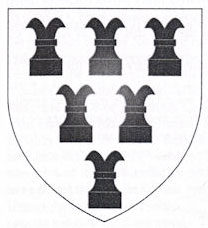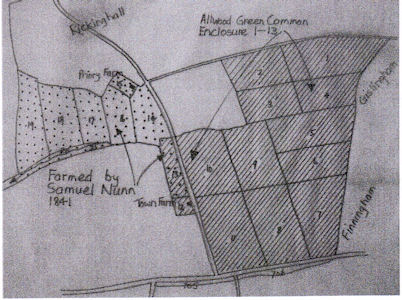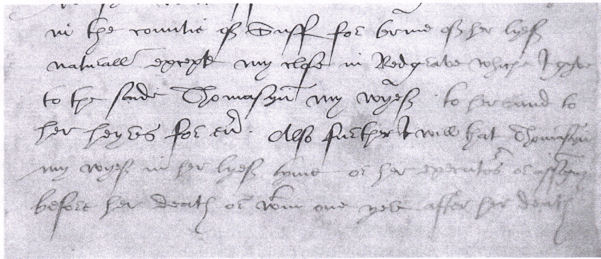The Rookwood Charity
Charity Number 213695–1 1568

The Walsham Manor Court Roll for April 1369 records that a John Hawes was fined 3d for leave to agree with John Rookwood in a plea of debt. Yet, unlike the Hawes and many other families, there is no further mention of the Rookwood family or indeed of a place called Rookwood within the parish of Walsham, so from where did Francis Rookwood, joint creator of Walsham’s Rookwood Charity in 1567, originate?
Elsewhere in Norfolk and Suffolk the Rookwoods abounded in the Middle Ages, controlling many manors and estates. One of the earliest recorded is Ralph, born in 1210 at Coldham Hall, Stanningfield, where the early 15th century church font has six chess rooks carved deeply into the stone.
The Coat of Arms of the Rookwood Family, Stanningfield
His descendent, Ambrose, born 1578 and married to Elizabeth Tyrwytt, was hanged at Tyburn on 31st january 1606 together with Henry Barrow of nearby Westhorpe for being conspirators in the Gunpowder Plot. Earlier, a close relative, Edward or Edmund Rookwood died in Bury Goal in 1598 having offended Queen Elizabeth 1 while she stayed at Euston Hall on her royal progress through East Anglia in 1578. Images of the Virgin Mary, proof of Rookwood’s continued support for the Catholic Church under a protestant monarch, had been uncovered at Euston and Elizabeth had them ceremonially burnt outside the hall before imprising Edward. By his involvement in the Gunpowder Plot did Ambrose seek to atone for his relative’s humiliation at Euston.
There may be three Francis Rookwoods of direct interest to us here in Walsham but records of proof are a problem for, as Catholic recusants, family baptisms and marriages are diffcult to find; they probably took place in a private chapel for which no records were kept or survive. Other records such as wills and administrations suggest that our man is Francis, seventh son of Edward and Alice rookwood of Euston Hall, born about 1530 and, because of his lowly postion in the family, in need of a rich wife.
John Hawes of Cranmer Green in Walsham made his will on the 26th November 1555…
‘and in the reign of Philip and Mary, by grace of God King and Queen of England, France, Naples, Spain, Sicily, Austria–.’
He left everything…
‘houses tenements lands both free and bonded to my wife Thomasyn for the term of her life and then to be sold’, …
the proceeds to be paid to a large number of recipients including his brother Richard and nephews James and John, there being no children of his marriage to Thomasyn. However, a close in Redgrave was given to Thomasyn and her heirs forever.
John Hawes died 1563 and his will was proved in 1566. By1568 Francis Rookwood and Widow Thomasyn Hawes were man and wife although an intensive trawl of over thirty parish registers failed to produce the proof. They had also set up the Rookwood Charity by a deed dated 3rd July 10 Elizabeth (1567). Thomasyn ws often used as a girl’s Christian name at this time as Review 68 shows by reference to Thomasin Smalpiece’s death in 1603.
A report on Charities in Suffolk written in 1840 includes the following entry under the parish of Rickinghall Superior.
‘Francis Rookwood and Thomasyne his wife, conveyed a close of 12 acres called Redgrave Close in the hamlet of Botesdale to trustees upon trust that the rents and profits there should be bestowed and employed amongst and for the relief of the poor inhabitants of the three several parishes of Walsham in the Willows, Rickinghall Superior and Rickinghall Inferior by the oversight of the ministers or curates and churchwardens of the said three parishes, one half fourteen days before Christmas and the other half fourteen days before Easter; and it was declared that after the decease of all but two of the trustees the survivors should convey the premises to themselves and such other persons and their heirs as should be nominated by the said churchwardens. The Charity Estate was last conveyed by deed, dated 6th March 1789 to new trustees, nominated by the churchwardens of whom only one is now living. On an indenture which took place about nine years ago (1831?) several pieces of land were alloted to each of the parishes in lieu of the Redgrave Close in the hamlet of Botesdale.’
The allocations are little more than half the original 12 acres; was the Charity short changed?
‘That allocated to Rickinghall Superior contains 2 acres 3 rods 11 perches; Rickinghall Inferior was alloted 2 acres 3 rods 2 perches; Walsham le Willows has an allotment of about 3 acres let to Samuel Nunn as a yearly tenant at 3 pounds 15 shillings and twopence a year and the rent is added to and laid out with that of the Town Estate.’
This was a Charity created from Walsham’s 86 acre portion of Allwood Green Common which was enclosed through the Parliamentary Enclosure Act of 1818 for the general benefit of the inhabitants of Walsham.

Walsham’s Tithe map of 1841 shows Samuel Nunn, a tenant of William Jegins, farming the 24 acres of Priory Farm made up of plots 14–21 inclusive, are Walsham’s share of the Allwood Green enclosure. Of these, plots 1–11 inclusive are all much greater than 6 acres; plot 12 is the Bailff’s House. Thus, I believe plot 13, a meadow of about 3 acres and adjoining plot 14 farmed by Samuel Nunn of Priory Farm represents the original Rookwood Charity Land and subject of the in lieu exchange of 1831(?). For about 100 years these lands were cultivated in part as allotments for the poor (see Review No 23) or rented out as a self contained farm. In 1954 this Town Farm was sold and the proceeds invested in the Town Farm Charity which makes periodic grants for the general benefit of the inhabitants of Walsham le Willows.
It seems to me that the original bequest of the Rookwood Charity in 1567 of a 12 acre close of land–Redgrave Close or Bretonnes Close in the hamlet of Botesdale–is the close of land bequeathed by John Hawes to his wife Thomasyn in perpetuity under his will of 1555. It also seems that the three parishes which benefitted from this bequest fared badly under the in lieu exchanges made under revisions in the early 19th century. In this 21st century we know a good deal about some of the present members of the Hawes family both at home and abroad; of the Rookwoods we know nothing. We have found no will for Francis who died in 1587, although like Thomasyn and her first husband John Hawes he is buried at Walsham. Todayrsquo;s telephone directories for Norwich, Cambridge and Ipswich contain not a single Rookwood entry. Perhaps you know differently.
Rob Barber
Acknowledgements
- Walsham Court Rolls 1351–1399 Ed Ray Lock
- Diane Maywhort, Rickinghall, for transcribing wills
- Christine Hood, www.pinpointyourpast.co.uk Rookwood family
- John Hawes’ will 1555
- Thomasyn Rockwood’s will 1584
- Visitation of Norfolk 1563 Ed. Dashwood 1878
- Charities in Suffolk report 1840 361.763
- Walsham Tithe Award 1841
- Walsham Village History reviews: No 23 Town Farm Allotments; No 36 The Town Farm Trust
THE GREAT WAR
HAROLD BENNETT was a captain in the Queen’s Gurkha Rifles. Shortly before the outbreak of war he was home on leave at his parents’ house, The Elms at Four Ashes. His father had been a Crown Agent for the Colonies and had retired to Suffolk in 1912.
Captain Bennett received an urgent message to join his regiment at Port Said in Egypt and travel with them to Marseilles, and then on to northern France. It was here that they met the Germans who had mounted a massive push to clear the road to Calais. The Indian troops suffered heavy losses, particularly the English officers who led them. These were handpicked men who knew their ways and spoke their language and were therefore difficult to replace. On 13th November 1914 Captain Bennett led an attack against the enemy. He was never seen again. Nearly three years passed before his parents received official notification of his death.
Bury Free Press 28th July 1917
‘He volunteered for a night attack and when last seen he was wounded in the right leg but still leading his men under searchlight and in the face of machine gun fire. There has been no further news of him and it is presumed his death took place at that time. Captain Harold Bennett of Walsham le Willows was aged 32. He was educated at Arnoldhouse, Llandulas and Uppingham. He served in the Boer War with the 5th Middlesex. He obtained a Commission with the Essex Regiment and was posted to India where he was appointed to the Indian Army.’
In the church, the cross above the chancel screen is to his memory. His name is on a panel of the Indian War Memorial at Neuve–Chapelle in France.
What The Papers Said…100 years ago
In October Sergeant George Clamp, son of the village blacksmith, wrote home to say he was well but twice had his horse shot dead beneath him.
In November it was reported that an oak–framed roll of Honour had been presented in the Walsham Men’s Institute by a Mr. A. Banyard. It contained the names of the 61 men from the village who were serving their country.


